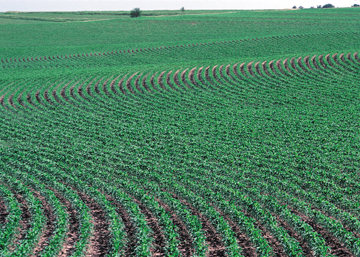|
Web Extra Thursday, June 21, 2007
Fill 'er up…with sugar?
 Courtesy of USDA NRCS, Tim McCabe |
| Corn-based ethanol, much of which is produced in Iowa, as shown here, is the most widely used biofuel in the United States. Ethanol is not the most efficient energy source, however, so researchers are trying to find the best way to produce biofuels from other plant materials, such as the stalks and woody parts. |
Traditionally, putting sugar in a gas tank is an act of treachery reserved only for one's enemies. Now, researchers are putting a new useful spin on a mean old trick by suggesting that renewable, clean-burning sugar derivatives might someday help replace liquid fossil fuels such as gasoline.
Currently, ethanol is the most widely used "biofuel" (a term describing any liquid fuel derived from plants or biomass). Approximately 4.86 billion gallons of corn-based ethanol were produced in the United States in 2006, according to the Department of Energy. Yet ethanol has its problems — one of which is that it is not very efficient compared to gasoline and other petroleum-based fuels. So researchers are trying to make ethanol more efficient, or to find new, better fuels.
And that's just what James Dumesic, a chemical engineer at the University of Wisconsin at Madison, and colleagues have done. They discovered a new method for obtaining combustible, energy-rich dimethylfuran (DMF) from fructose, the simple sugar found in plants ranging from parsnips to peaches.
Compared to ethanol, DMF is more energy dense by 40 percent, has a higher boiling point, and is not soluble in water, Dumesic and colleagues wrote in an article published today in Nature.
A higher boiling point means DMF is less volatile than ethanol, which is slightly too volatile, Dumesic says. DMF's insolubility with water means it won't absorb water from the air, staying pure from synthesis to combustion. Its higher energy density means that a full tank of DMF will get you 40 percent farther than a full tank of ethanol. According to the authors, the combination of these properties makes DMF a better fuel than ethanol, which many had hailed as the future of biofuels.
Synthesis of DMF begins with fructose, which is obtained from the fruity parts of plants. Removing oxygen from each fructose molecule makes a compound called hydroxymethylfurfural (HMF). HMF is a valuable alternative to petroleum products used in the plastics industry, Dumesic says, but is not volatile or energy-rich enough to be a liquid fuel. For that, HMF is further reduced to yield DMF, which possesses "specific physical properties that allow for efficient distribution, storage, and combustion," the researchers wrote.
In a separate study published June 15 in Science, Haibo Zhao and colleagues at the Pacific Northwest National Laboratory in Richland, Wash., say they have derived HMF directly from glucose instead of fructose, a finding that Dumesic calls "very promising," as glucose is preferred as a source for HMF and DMF over fructose. Glucose, which had previously proven difficult to derive HMF and DMF from, is the primary sugar found in cellulose and is far more abundant naturally than fructose. Because cellulosic material (the woody, stalky parts of plants traditionally discarded as "chaff") is abundant and largely unused, researchers would rather obtain the sugar — and thus the fuel — from cellulosic material than from fruits. Using waste instead of food for fuel might alleviate concerns that the wide-scale cultivation of crops bound for gas tanks and not dinner plates would raise food costs or cause food shortages.
Although DMF shows great promise as a potential renewable fuel, it may be awhile before we see it in widespread use, Dumesic says. "Studies have to be conducted to determine whether DMF has any negative effects on the environment before we would consider the widespread use of DMF in the transportation sector," he explains.
Biofuel production has doubled worldwide since 2001
but still represents only 1 percent of the global fuel market, according to
the Worldwatch Institute. Most biofuels are fats (biodiesel) or alcohols (ethanol).
As a sugar-derived biofuel, DMF is unique, but perhaps a harbinger of things
to come, Dumesic says. "Overall, sugars make up about 75 percent of all
biomass; thus, I would expect that any renewable bio-energy strategy will have
to deal effectively with the processing of sugars" he says.
Links:
"Weighing
in on Renewable Energy Efficiency," Geotimes, August 2005
"Turning
Trash Into Energy," Geotimes, February 2006
"Bush
addresses alternative energy," Geotimes online, Web Extra, Feb.
3, 2006
Back to top

 Subscribe
Subscribe


